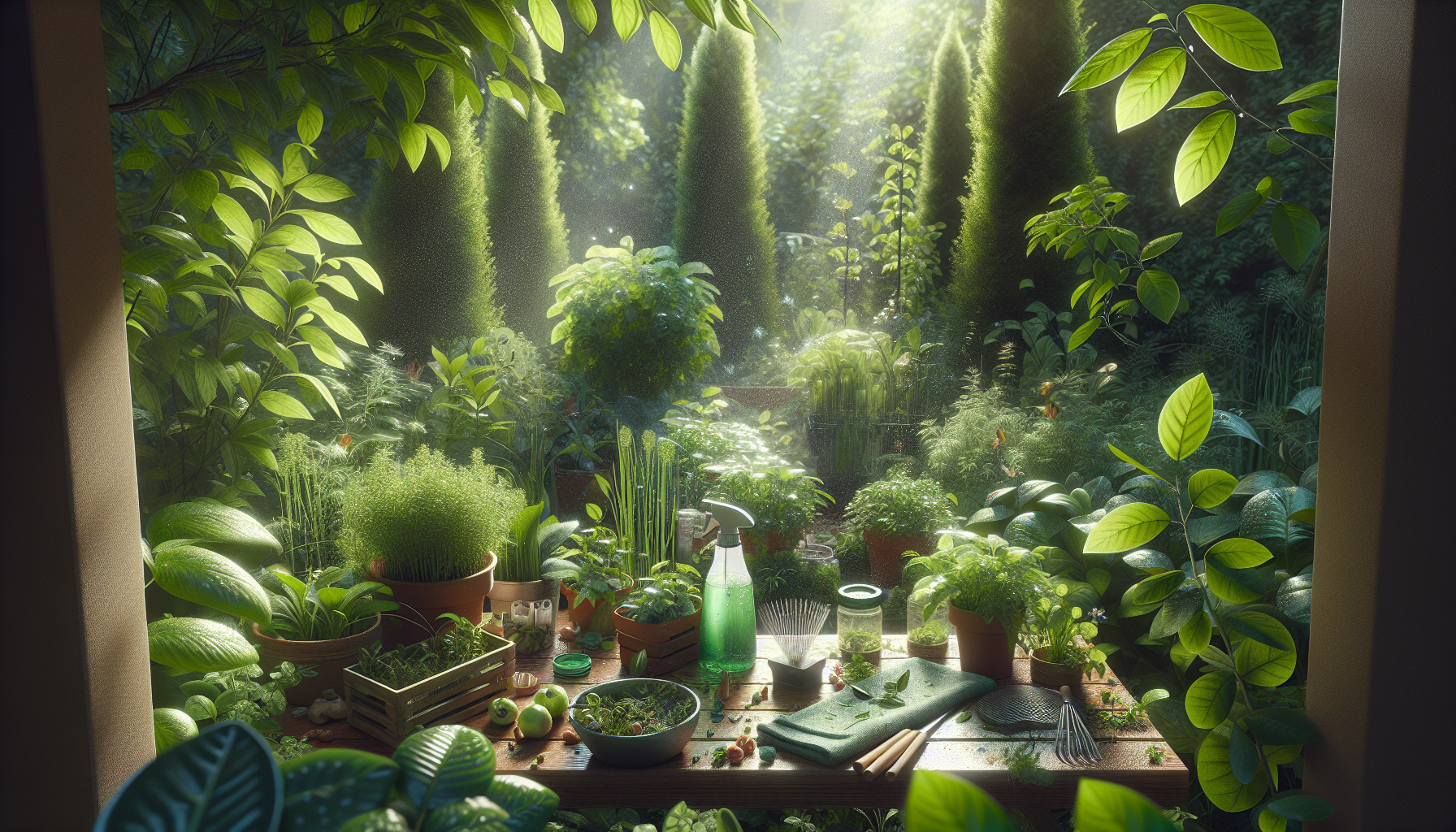In the serene corners of our homes, where the chaos of daily life seems to pause, we often find solace in our gardens. These vibrant spaces offer not only a retreat for the soul but also a canvas where we can cultivate beauty and nurture life. However, this oasis of tranquility can quickly become a battleground when household pests decide to make an uninvited appearance. Imagine pouring your time, energy, and love into nurturing a lush garden, only to find your precious plants under siege from these tiny invaders. Frustrating, isn’t it? 🌿
In this comprehensive guide, “Keep Your Garden Green: Top Tips for Protecting Your Plants from Pesky Household Pests,” we delve into the myriad challenges faced by gardeners in preserving their verdant sanctuaries. Our goal is to equip you with practical strategies and insightful tips to defend your garden against these persistent adversaries. Whether you’re a seasoned horticulturist or a budding enthusiast, understanding how to protect your plants from pests is crucial to maintaining a flourishing garden.
First, we’ll explore the common types of household pests that can wreak havoc in your garden, from aphids and slugs to more elusive culprits like spider mites and whiteflies. Understanding the characteristics and behaviors of these pests is the first step in combating them effectively. We’ll provide detailed profiles on each pest, helping you identify the telltale signs of their presence and the specific threats they pose to your plants.
Next, we’ll discuss prevention strategies that can deter pests before they ever become a problem. These proactive measures include everything from selecting pest-resistant plant varieties to implementing companion planting techniques that naturally repel unwanted visitors. We’ll also cover essential garden maintenance practices, such as proper watering, soil management, and regular plant inspections, which can create an environment that is inhospitable to pests.
Finally, for those moments when prevention isn’t enough, we’ll delve into a variety of pest control methods. Our focus will be on sustainable and eco-friendly solutions that protect not only your garden but also the broader ecosystem. From homemade organic sprays and natural predators to the judicious use of commercial products, we’ll equip you with a toolbox of effective responses to manage pest outbreaks without resorting to harmful chemicals.
Embark on this journey with us as we uncover the secrets to maintaining a healthy, vibrant garden in the face of pest pressures. By the end of this article, you’ll have the knowledge and confidence to keep your garden thriving, ensuring that your green space remains a haven of peace and beauty. So, roll up your sleeves, grab your gardening gloves, and let’s get started on transforming your garden into a pest-free paradise! 🌻
Understanding Household Pests and Their Impact on Gardens
Gardening is a fulfilling hobby for many, offering not only a connection to nature but also a source of fresh produce and beautiful flora. However, one of the biggest challenges gardeners face is the invasion of household pests. These unwelcome visitors can wreak havoc on your plants, diminishing the aesthetic appeal of your garden and sometimes even killing the plants you’ve worked so hard to cultivate. Understanding these pests and the impact they have on your garden is crucial for effective pest management.
Household pests can range from insects like aphids, caterpillars, and beetles to larger creatures such as rodents and birds. Each type of pest brings its own set of challenges and requires specific strategies for control. Insects, for example, often feed on plant leaves, stems, and roots, causing direct damage to the plant’s structure. This feeding can lead to a reduction in plant vigor, stunted growth, and even plant death if not managed properly. Additionally, some insects act as vectors for plant diseases, introducing pathogens that can lead to further damage or the spread of illness among your garden plants.
Larger pests, like rodents, can cause physical damage by digging up roots and tubers or nibbling on fruits and vegetables. Birds, while often seen as beneficial for insect control, can also become a problem when they start feeding on seeds and fruits. The impact of these pests extends beyond the immediate physical damage. They can disrupt the ecological balance of your garden, leading to a decrease in beneficial insect populations and a shift in the plant community structure. Understanding these dynamics is essential for developing a comprehensive pest management strategy.
Effective Strategies for Pest Prevention
Preventing pests from entering your garden is often more effective than dealing with an infestation. A combination of cultural, mechanical, and biological strategies can be employed to create an environment that is less conducive to pest invasions. Cultural practices involve modifying the way you garden to discourage pests. This can include crop rotation, companion planting, and maintaining proper garden hygiene. Crop rotation, for example, disrupts the life cycles of pests by changing the type of plants available for them to feed on each season. Companion planting involves growing certain plants together to naturally repel pests or attract beneficial insects that can help control pest populations.
Mechanical controls are physical barriers that prevent pests from reaching your plants. These can include row covers, nets, and fences. Row covers are lightweight fabrics that are draped over plants to protect them from flying insects and small mammals. Nets and fences can be used to keep out larger pests like birds and rodents. These methods are effective in reducing pest access without the use of chemicals, making them an environmentally friendly option.
Biological control involves using natural predators or parasites to manage pest populations. This strategy takes advantage of the natural food chain by introducing or encouraging the presence of beneficial insects like ladybugs, which feed on aphids, or parasitic wasps, which target caterpillars. Encouraging a diverse ecosystem within your garden can help maintain a balance between pests and their natural enemies, reducing the likelihood of severe infestations.
Implementing Integrated Pest Management (IPM)
Integrated Pest Management (IPM) is a holistic approach that combines multiple strategies for sustainable pest control. It focuses on long-term prevention and minimal environmental impact. The first step in IPM is monitoring your garden regularly for signs of pest activity. This can include looking for physical damage on plants, observing the presence of pests, or using traps to capture and identify insects.
Once you have identified a pest problem, the next step is to evaluate the severity of the infestation and the potential damage to your plants. This will help you determine the most appropriate control measures. IPM encourages the use of non-chemical methods first, reserving chemical interventions as a last resort. If chemical controls are necessary, choosing targeted and environmentally friendly products is recommended to minimize harm to beneficial insects and the surrounding ecosystem.
A key component of IPM is ongoing education and adaptation. As pest populations and environmental conditions change, so should your pest management strategies. Staying informed about new pest control methods and monitoring the effectiveness of your current practices will help ensure the long-term health and productivity of your garden.
Natural Pest Control Solutions
For gardeners who prefer to avoid chemical pesticides, there are numerous natural pest control solutions available. These methods are not only safer for the environment but also for humans and pets. One popular natural control method is the use of neem oil, a plant-based pesticide that disrupts the growth and reproduction of insects. Neem oil is effective against a wide range of pests, including aphids, spider mites, and whiteflies. It can be applied as a foliar spray, providing a protective coating on plant surfaces that deters insect feeding.
Another natural solution is the use of diatomaceous earth, a powder made from the fossilized remains of tiny aquatic organisms. Diatomaceous earth works by dehydrating insects, making it effective against soft-bodied pests like slugs and caterpillars. When applying diatomaceous earth, it is important to use food-grade products and avoid inhaling the fine powder.
Companion planting is another natural pest control strategy that can be highly effective. Certain plants have properties that repel pests or attract beneficial insects. For example, planting marigolds alongside vegetables can help deter nematodes, while flowering herbs like dill and fennel can attract ladybugs and other predatory insects. By carefully selecting companion plants, you can create a garden environment that naturally reduces pest pressures.
Creating a Balanced Ecosystem in Your Garden
A healthy, balanced ecosystem is the foundation of effective pest control. By fostering biodiversity in your garden, you can create a habitat that supports a wide range of organisms, from beneficial insects and pollinators to soil microbes and fungi. This diversity helps regulate pest populations naturally, reducing the need for intervention.
One way to promote biodiversity is to incorporate a variety of plant species in your garden. A diverse plant community provides different habitats and food sources for insects and other wildlife, encouraging a balanced ecosystem. Additionally, leaving areas of your garden undisturbed can provide shelter for beneficial organisms and allow natural processes to occur.
Another important aspect of creating a balanced ecosystem is soil health. Healthy soil supports robust plant growth, making plants less susceptible to pest damage. Practices such as composting, mulching, and using organic fertilizers can improve soil fertility and structure, promoting healthy root development and plant vigor.
Using Technology and Innovation in Pest Control
Technology and innovation are playing an increasingly important role in modern pest control. From digital pest monitoring systems to advanced biopesticides, new tools are making it easier for gardeners to protect their plants from pests. Digital monitoring systems, for example, use sensors and cameras to detect pest activity and alert gardeners to potential problems. These systems can be integrated with mobile apps, allowing gardeners to monitor their gardens remotely and respond quickly to pest issues.
Biopesticides, which are derived from natural materials like plants and microbes, offer another innovative approach to pest control. These products are designed to target specific pests without harming beneficial insects or the environment. Advances in biopesticide technology are leading to more effective and targeted solutions, providing gardeners with new tools for sustainable pest management.
Embracing a Sustainable Approach
Sustainability is a key consideration in modern pest control practices. By focusing on long-term solutions that minimize environmental impact, gardeners can protect their plants while also preserving the health of the ecosystem. Sustainable pest control involves using a combination of methods, including cultural, mechanical, and biological strategies, to manage pests in a way that is both effective and environmentally friendly.
Embracing a sustainable approach requires ongoing education and adaptation. As new technologies and methods become available, gardeners should stay informed and be willing to adjust their practices accordingly. By prioritizing sustainability, gardeners can contribute to a healthier planet while also enjoying the beauty and bounty of their gardens.
- Understand the types of household pests and their impact on your garden.
- Implement effective strategies for pest prevention, including cultural, mechanical, and biological controls.
- Use natural pest control solutions like neem oil and diatomaceous earth.
- Promote a balanced ecosystem in your garden through biodiversity and soil health.
- Utilize technology and innovation for modern pest control solutions.
| Pest Type | Damage Caused | Control Method |
|---|---|---|
| Aphids | Feed on plant sap, causing wilting and yellowing of leaves | Neem oil, introduction of ladybugs |
| Caterpillars | Chew leaves and stems, can defoliate plants | Diatomaceous earth, parasitic wasps |
| Rodents | Dig up roots, eat fruits and vegetables | Fencing, traps, repellents |

Conclusion
As we draw our exploration of plant protection to a close, it is important to revisit the valuable insights and practical strategies we have discussed to ensure your garden remains a verdant oasis, free from the intrusion of pesky household pests. Throughout this article, we delved into a variety of techniques that serve not only to safeguard the health of your plants but also to enhance your enjoyment of gardening as a rewarding and sustainable hobby.
First and foremost, we emphasized the necessity of understanding the common household pests that can wreak havoc in your garden. From aphids and spider mites to slugs and snails, each pest presents its unique challenges. By familiarizing yourself with these invaders, you can take proactive measures to prevent infestations and address them effectively when they do occur. Recognizing early signs of pest activity and understanding their life cycles are key components in this defensive strategy. This awareness allows for timely interventions, reducing the need for more aggressive control measures later on.
Furthermore, we explored natural and organic methods as the first line of defense against garden pests. These eco-friendly solutions not only protect the environment but also ensure that your garden remains safe for pollinators, pets, and humans. Techniques such as introducing beneficial insects, utilizing companion planting, and making homemade pest repellents from everyday household items were highlighted as effective and sustainable options. These methods promote a balanced ecosystem in your garden, allowing nature to manage pest populations in a harmonious manner.
In addition to these natural approaches, we discussed the importance of maintaining good garden hygiene. Regular cleaning of fallen leaves, debris, and dead plants reduces breeding grounds for pests. Moreover, practicing crop rotation and ensuring proper plant spacing can significantly deter pest infestations. By creating an inhospitable environment for pests, you naturally reduce their presence and protect your plants from potential damage.
The article also touched upon the role of physical barriers and traps in pest management. Simple solutions such as netting, row covers, and copper tape can be highly effective in keeping pests away from vulnerable plants. Similarly, using traps strategically can help monitor and control pest populations without resorting to chemical pesticides.
Importantly, we considered the judicious use of chemical pesticides as a last resort. While these products can be effective in controlling severe infestations, they should be used sparingly and with caution, always adhering to the manufacturer’s instructions. By prioritizing natural methods and maintaining vigilant observation, you can often avoid the need for chemical interventions altogether.
As we conclude, the importance of protecting your garden from pests cannot be overstated. A healthy, thriving garden contributes to the overall well-being of our environment, supports biodiversity, and provides a sanctuary of beauty and tranquility for you and your loved ones. By implementing the strategies discussed in this article, you are not only preserving your personal green space but also promoting sustainable gardening practices that benefit the broader ecosystem.
We encourage you to share your own experiences and tips in the comments section below. Gardening is a community effort, and by exchanging knowledge, we can all become better stewards of our natural surroundings. Feel free to share this article with fellow gardening enthusiasts who may also benefit from these insights. Together, we can cultivate gardens that are not only lush and productive but also resilient against the challenges posed by household pests.
In closing, remember that the journey of maintaining a healthy garden is ongoing and evolving. Each season brings new challenges and opportunities to learn. Embrace this journey with curiosity and dedication, knowing that your efforts are contributing to a greener, more sustainable world. 🌿✨
For further reading and resources, you might find these links helpful:
– The Old Farmer’s Almanac: Organic Pest Control
– Royal Horticultural Society: Pest and Disease Advice
Thank you for joining us on this journey to keep your garden flourishing and pest-free. Happy gardening!
Toni Santos is a visual storyteller and botanical artisan whose creations explore the wild elegance of carnivorous and exotic plants. With a deep reverence for nature’s most mysterious flora, Toni captures the untamed beauty of insect-eating mechanisms, alien-like blooms, and resilient life thriving in extreme environments.
Rooted in a lifelong fascination with the strange intelligence of plants, his work blends science, symbolism, and storytelling. From the snap of a Venus flytrap to the labyrinthine curves of a Nepenthes pitcher, each piece Toni creates reveals a deeper narrative — one of survival, adaptation, and the subtle power of nature’s most unexpected designs.
With a background in visual design and handcrafted artistry, Toni merges technique with intention, crafting illustrations, collections, and visual studies that not only depict these botanical wonders — but evoke their hidden magic. His inspiration often comes from ancient lore, natural history, and the eerie elegance of ecosystems where these plants thrive.
As the creative force behind Vizovex, Toni shares this botanical fascination with the world, offering curated artwork, stories, and pieces that help others reconnect with nature’s wilder, more enigmatic side.
His work is a tribute to:
The fierce beauty of carnivorous plants
The visual language of adaptation and survival
The mysteries of exotic flora in forgotten habitats
Whether you’re a plant enthusiast, a science lover, or someone drawn to the strange and beautiful, Toni welcomes you into a world where every leaf hides a secret — one trap, one tendril, one story at a time.





